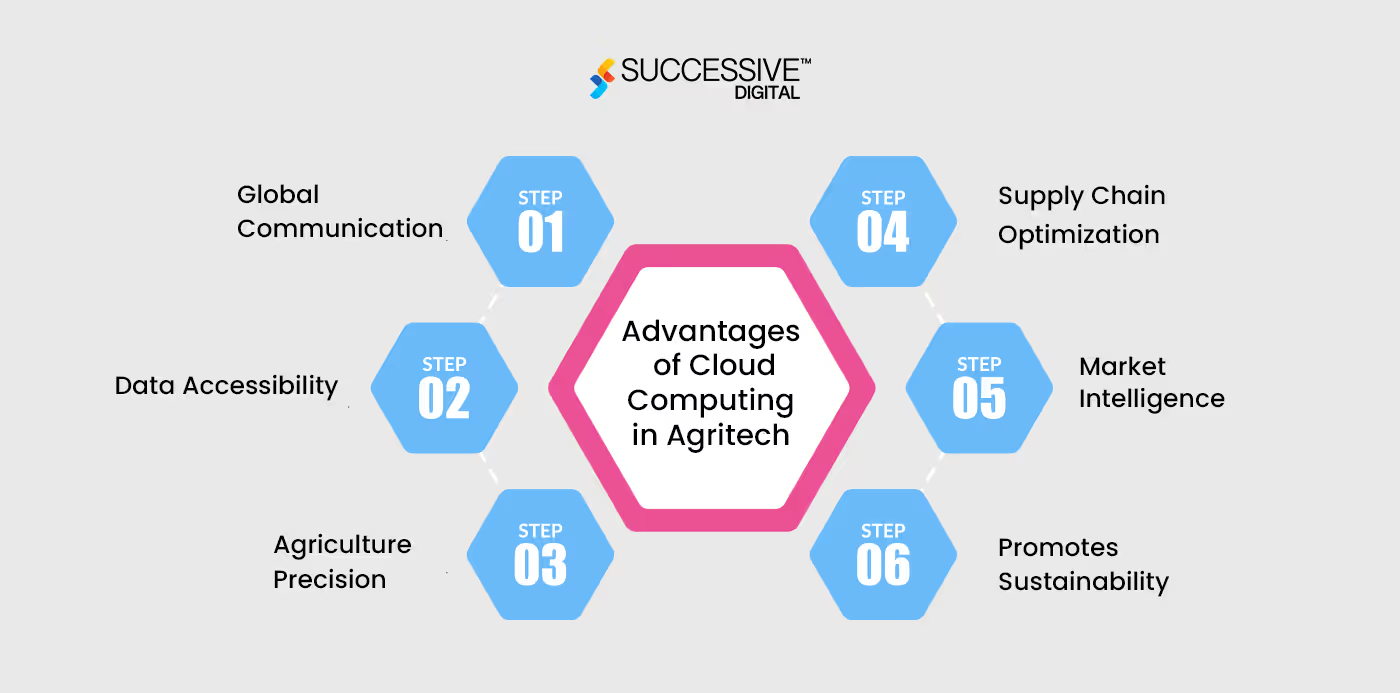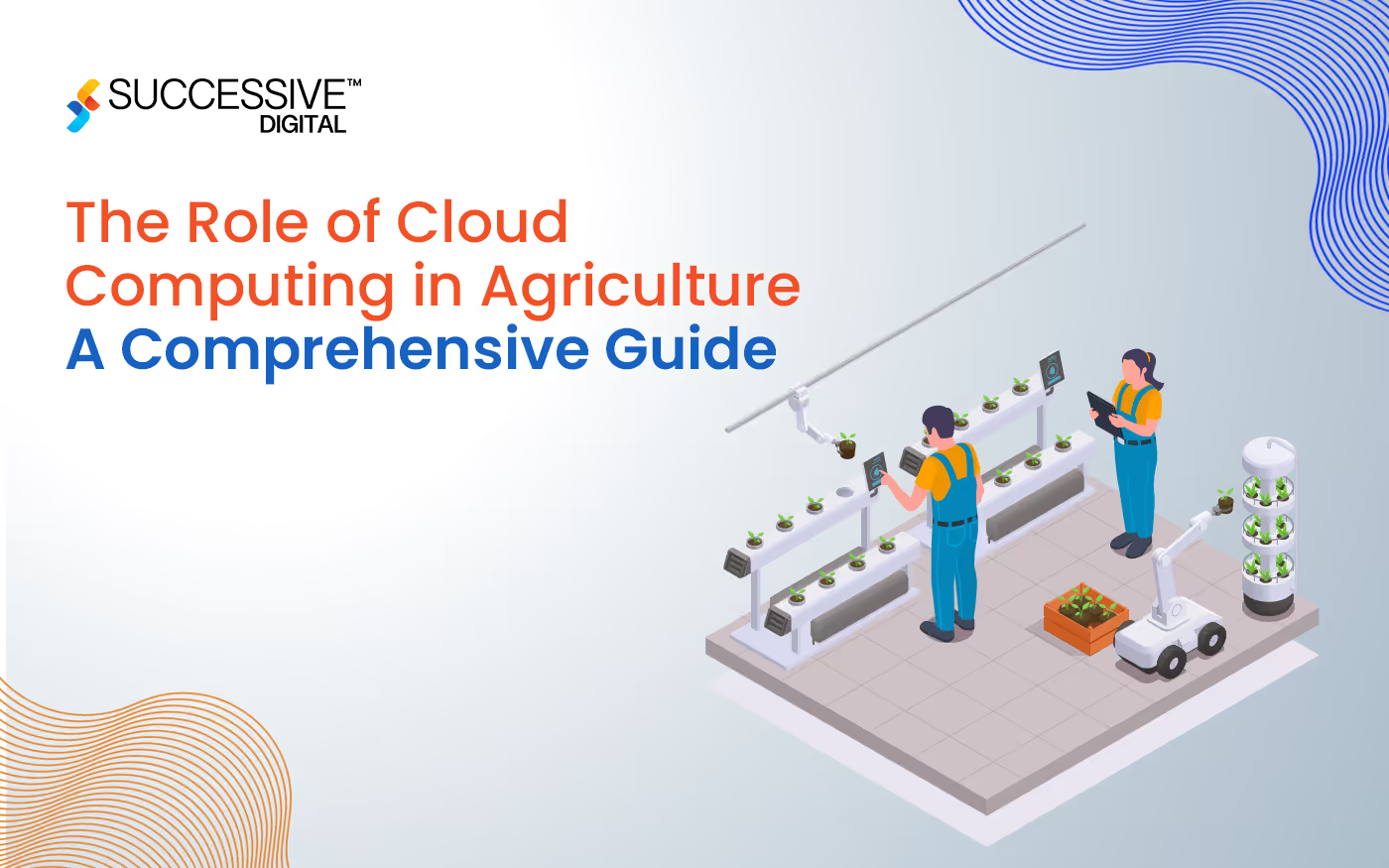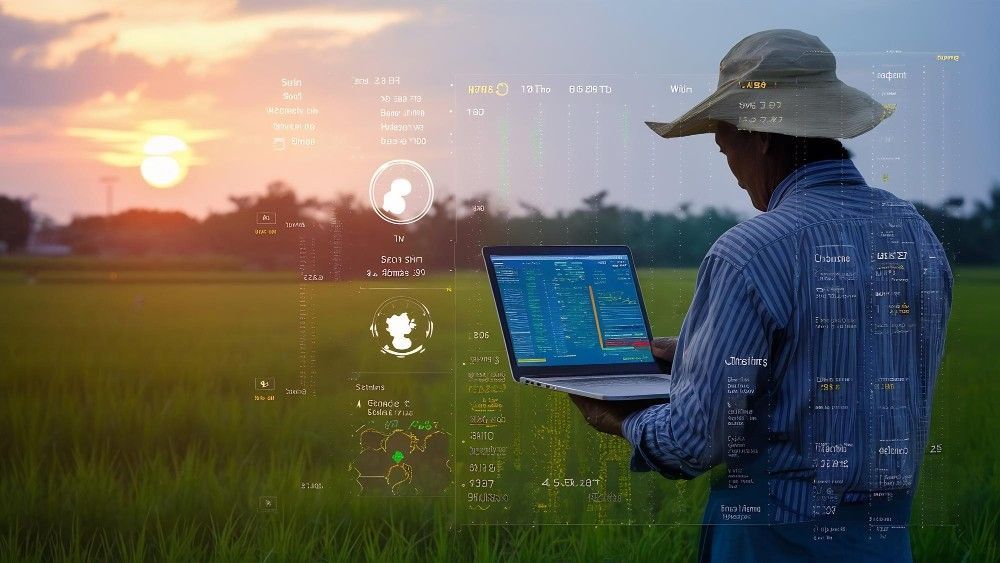Agriculture is humanity's oldest occupation. It has long relied on traditional methods and concepts. However, the season of change is here, and it is time for agriculture to embrace the most acknowledged technological advancements. One of the most significant shifts we are witnessing is the adaptation of cloud computing in agriculture. Agriculture is in the early phases of a new dawn, with data and connectivity at its core. Farmers can increase yields using improved seed, irrigation, and fertilizers. Cloud computing, artificial intelligence, analytics, networked sensors, and other emerging technologies promise to increase yields, advance irrigation and other input efficiency, and promote sustainability and resilience in crop production and other agricultural sectors, proposing a hopeful future for farmers. This blog will help you understand the impact of cloud computing in agriculture and how your business can benefit from it.
Cloud Computing in Agriculture: An Overview
Agribusinesses can use cloud-based solutions to improve operational efficiency, inventory tracking, and supply chain management. Cloud computing in agriculture can help farmers with smart agriculture by using cloud-based data and IoT to make data-driven product decisions. Here are a few ways how cloud computing impacts agriculture:
- Enables precision farming tools, real-time monitoring, and accurate crop management.
- Collects data from sensors, drones, and satellites to optimize resource usage and improve crop health.
- Allows real-time product tracking, optimizes logistics, and expands market access for improved supply chain management.
- Utilizes IoT devices for remote monitoring and regulation of crops and livestock, saving time and effort.
- Cloud platforms foster collaboration and knowledge exchange among farmers, researchers, and policymakers.
- Access to real-time data and predictive analytics enhances decision-making and minimizes risk.
- Promotes sustainability by reducing adverse environmental effects and ensuring long-term agricultural viability.
The Application of Cloud Computing in Agriculture
Agriculture is the most untouched by technology and essential for human survival. Let’s explore how cloud computing helps in agriculture:
1. It Captures Crop Information
Cloud computing in agriculture can gather all the data on crops grown recently. Therefore, using cloud computing in agriculture can assist farmers in determining what to plant next on a given piece of land. Weather forecasts and local meteorological data can be stored on cloud servers for a specific time. Even this is essential for assisting farmers in selecting crops wisely.
2. It Gathers Soil Information
Cloud-powered applications for agriculture focus on collecting soil information. These applications are designed to identify soil profiles and their past trends, thus significantly helping farmers understand future trends. For example, is the soil becoming more acidic, or are there other visible changes in soil composition?
3. It Captures Cultivators’ Data
Authorities can record, monitor, and investigate the activities and involvement of local cultivators. This application of cloud computing in agriculture helps in identifying core agricultural areas that policymakers may utilize to develop plans.
4. It Opens a Space for Retail
Farmers are typically unable to bring their produce to market directly. Middlemen emerge between them and the retail market, exploiting growers. Farmers can now deliver their goods directly to retailers or end consumers using cloud technology.
5. It Enables Effective Information Sharing
Scientists working in agricultural research can use the cloud to share their ideas and discoveries directly about adopting current agriculture and fertilizer methods.Read this blog to know -How Digital Transformation is Growing the Agritech Sector: Sowing Seeds of Innovation
Advantages of Cloud Computing in Agritech
Cloud computing in agriculture impacts the sector in various ways, offering numerous advantages that enhance productivity, efficiency, and sustainability. Below are the key benefits of cloud computing in agriculture:

1. Global Communication
Cloud computing in agriculture enables global communication, bridging the gap between farmers, agronomists, researchers, and stakeholders. Below are some points that help you understand how cloud computing allows global communication:
- Allow for the immediate sharing of weather updates, crop health information, and market trends, allowing for more informed decision-making.
- Farmers can collaborate with experts worldwide to implement best practices and ideas, regardless of geography.
- Cloud-based training modules and webinars are available globally, ensuring farmers remain current on the latest advances in agritech.
2. Data Accessibility
Cloud computing in agriculture ensures that essential data is accessible at all times and from any location. This accessibility results in the following:
- Farmers can store and access data like soil health reports, crop performance, and machinery logs in a single and safe location.
- Farmers can use cloud-based tools to remotely monitor field conditions and make educated decisions without being physically present.
- Integrating data from multiple sources (sensors, satellites, and weather stations) into a single platform facilitates further actions.
3. Agriculture Precision
Fueled by cloud computing in agriculture, precision agriculture improves farming operations through accurate data analysis. Benefits of cloud computing in agriculture iinclude:
- Farmers can use data on soil conditions, weather patterns, and crop health to administer water, fertilizers, and pesticides more precisely, minimizing waste and increasing yields.
- Cloud-based prediction algorithms can forecast crop performance and insect outbreaks, enabling preventative interventions to be performed.
- Integration with IoT devices automates irrigation systems, drones, and machinery, increasing precision and efficiency.
4. Supply Chain Optimization
Cloud computing streamlines the agricultural supply chain from farm to fork. The points jotted down below explain how cloud computing in agriculture enables supply chain optimization:
- Cloud-based technologies monitor inventory levels, detect shortages, and automate reordering procedures, resulting in a smooth supply chain.
- Cloud computing in agriculture allows for real-time tracking of shipments and delivery, which improves logistics management by decreasing delays and spoiling.
- Improved traceability via cloud platforms enables better tracking of produce, assuring quality and regulatory compliance.
5. Market Intelligence
Access to cloud-based market intelligence solutions provides farmers with vital information about industry trends and consumer preferences.
- Farmers may obtain real-time pricing data and trend studies, allowing them to make more educated decisions about when and where to sell their produce.
- Understanding market demand allows farmers to plan their production cycles better and satisfy the needs of their customers.
- Cloud computing in agriculture allows farmers to change their strategy by evaluating competition data to remain competitive in the market.
6. Promotes Sustainability
Cloud computing in agriculture promotes sustainable agricultural methods, benefiting the environment and the farming community.
- Efficient use of resources like water and fertilizer lowers environmental impact and expenses.
- Optimized logistics and waste reduction lead to a smaller carbon footprint for agricultural operations.
- Data-driven agricultural practices enhance crop diversification and soil health, which helps to maintain long-term ecological balance.
Learn how the green revolution came with technology-The Green Revolution 2.0: Digital Transformation’s Role in Advancing AgriTech
Cloud Computing Use Cases for the Agritech Industry
Cloud computing in agriculture is dynamic and helps agronomists, farmers and consumers in multiple ways. Below are some use cases of cloud computing in agriculture:

✅Precision Farming
Data Collection and AnalysisPredictive AnalyticsSensors and IoT Devices collect information on soil moisture, temperature, and crop health, which cloud platforms combine for thorough analysis. Farmers can make more informed decisions regarding planting, irrigation, and harvesting, resulting in increased production and resource efficiency.Cloud-based models analyze weather patterns to forecast conditions, allowing farmers to organize their activities. AI algorithms in the cloud scan satellite photos to detect diseases early, allowing for prompt therapies.
✅Supply Chain Optimization
Real-Time Inventory ManagementEnhanced TraceabilityCloud-based solutions monitor inventory levels in real time, ensuring prompt replenishment and eliminating waste. Analytics predict demand trends, helping farmers align production with market needs.Cloud services ensure transparency and traceability from farm to table, boosting consumer trust and regulation compliance.
✅Farm Management Solutions
Resource ManagementRemote Monitoring and ControlCloud platforms analyze data from irrigation systems to optimize water usage, conserve resources, and reduce costs. By monitoring energy consumption, farms can maximize the use of machinery and reduce operational costs.Drones and remote sensors send data to the cloud, allowing farmers to monitor crops and livestock without being physically present. Cloud-based applications remotely control farm equipment and systems, increasing efficiency and reducing labor costs.
✅Market Access and Financial Services
Digital MarketplacesFinancial ServicesCloud-based marketplaces connect farmers directly with buyers, expanding their market reach and increasing profitability. Cloud solutions provide insights into market trends and pricing strategies, helping farmers get the best product prices.Cloud platforms facilitate access to agricultural insurance and credit by analyzing data on farm performance and risk factors. Governments and organizations use cloud systems to manage and distribute subsidies effectively, ensuring that support reaches the intended beneficiaries.
✅Sustainable Practices
Environmental MonitoringSmart Farming TechniquesCloud tools monitor and report on carbon emissions and other environmental impacts, helping farms adopt sustainable practices. Data analytics in the cloud assess the impact of farming on local ecosystems, promoting biodiversity-friendly farming methods.Cloud-based systems manage vertical farms in urban areas, optimizing space and resources for sustainable crop production. Hydroponics and Aquaponics are managed and monitored through cloud platforms, ensuring optimal growth conditions and resource use.
Real-World Examples of Cloud Computing in Agriculture
You must have understood how cloud computing impacts agribusinesses and how crucial it is to utilize it to stay ahead of the competition. Let’s explore how the agritech organizations around us are utilizing cloud computing to enhance their business:
1. Precision Farming with Climate Corporation:
Climate Corporation, a part of Bayer, offers precision farming using cloud computing solutions. FieldView, the cloud corporation's platform, collects data from various sources, including weather stations, satellite photography, and IoT devices installed on farms. This platform provides farmers with insights about ideal planting periods, crop health, and yield prediction by processing and analyzing this data in the cloud. This facilitates farmers in making data-driven decisions that enhance yield with effective resource utilization.
2. John Deere’s Operations Center:
John Deere, a prominent name in agriculture, uses cloud computing to improve the functionality of its products. Their operation centers collect data from tractors and other machines fitted with sensors and GPS. This data is then evaluated in the cloud, providing farmers real-time updates on equipment performance, field conditions, and crop progress. The solutions offered by cloud computing in agriculture enable remote diagnosis and maintenance, which reduces downtime and increases productivity.
3. Smart Irrigation Systems by Netafim
Netafim is an advanced organization and is known for its drip irrigation technology. It optimizes agricultural water usage using cloud computing. Their NetBeat technology deploys IoT sensors to monitor soil moisture, meteorological conditions, and crop requirements. This information is sent to the cloud, where the advanced algorithms analyze it to share precise irrigation suggestions. Farmers can remotely operate their irrigation systems using a smartphone app, ensuring that crops receive the proper amount of water at the correct time, resulting in significant water savings and increased crop yields.
4. Livestock Monitoring with Allflex Livestock Intelligence:
Allflex Livestock Intelligence, a division of MSD Animal Health, utilizes cloud computing to manage livestock efficiently. Their monitoring systems track the animals' health, behavior, and whereabouts using RFID tags and sensors. Then, the collected data is transmitted to the cloud and evaluated for patterns and abnormalities. With such solutions offered by cloud computing in agriculture, farmers get alerted to potential health issues, breeding cycles, and optimal feeding times, allowing for prompt interventions to increase animal welfare and output.
5. AgriTech Solutions by Successive Digital:
Successive Digital provides various cloud consulting services in agriculture that are designed explicitly for the industry. These services include Precision Agriculture, Supply Chain Management, Weather Forecasting, Farm Monitoring Management, Livestock management etc. These services offered by Successive Digital can help you improve agri-food systems by bringing innovative thinking and multidisciplinary expertise, where every crop, season, and acre is powered by tech-driven intelligence. To help farmers and agribusiness organizations increase farm profitability and yield, these Agritech solutions let you navigate volatile markets, maximize yields, and ensure food security.
6. Crop Management with Taranis:
Taranis is an agritech startup that utilizes cloud computing to give high-resolution aerial photography and crop management data analytics. Their software collects data from drones, satellites, and field sensors. Then, this data gets analyzed in the cloud to provide specific information about crop health, pest infestations, and nutrient shortfalls. Farmers can access this data via a user-friendly dashboard, enabling them to take necessary steps to safeguard and improve their crops.
7. Trace Genomics:
Trace Genomics offers a cloud-based soil analysis service. It helps farmers understand the microbiological composition of soil. After analyzing samples using modern genetic techniques, farmers can receive detailed results. The data is processed and saved in the cloud, allowing farmers to obtain soil health information. This solution enables farmers to make intelligent decisions about soil management, crop selection, and fertilization.
A Success Story of Growers Utilizing AWS Cloud Compute
Growers, a multi-vendor eCommerce marketplace, facilitate farmers' and retailers' transformation of the agricultural supply chain with a collaborative platform that improves farming operations and transactions. They wanted to offer convenience to their agricultural ecosystem by implementing precision technologies and streamlining the bidding process.We helped them by utilizing AWS resources and Node.js for the backend. The platform provides end-to-end functionality while maintaining optimal performance. The emphasis on user-friendliness resulted in a highly performant mobile application that improves client engagement. Despite its complexity, we kept the mobile application's original PWA functionality while integrating key business functionalities.Growers collaborated with Successive Digital to create a scalable, future-ready platform that connects small-scale farmers to large corporations. We helped Growers create the Smart Agriculture Mobile platform, which uses AWS for infrastructure and integrates procurement, supply chain management, financial control, and data-driven analytics. This method promotes transparency, equitable pricing, and user trust.Terraform for infrastructure management, Docker containers with Amazon ECS, and AWS Fargate for serverless computing contributed to increased security and scalability. Additional AWS services have improved platform capabilities, such as Amazon EventBridge, AWS Lambda, DynamoDB, and PostgreSQL on RDS. This unified platform increased productivity and profitability by accelerating IT and development cycles, shortening time-to-market, lowering expenses, and improving customer interaction via effective email communication.
Conclusion
Cloud computing is impacting the entire world. The results are the changes we have in our daily lives; from smart houses to smart farming- cloud computing solutions are implemented everywhere. At Successive Digital, we empower agribusinesses with efficient software solutions; we enable the implementation of smart farming methods that reduce expenses and ensure consistent yield and growth. Our Agritech solutions are built on a foundation of the Internet of Things, data analytics, visualization capabilities, and deep industry knowledge. This allows farmers to increase productivity and profitability, leveraging our extensive expertise and experience.
.avif)










.webp)





.jpg)









